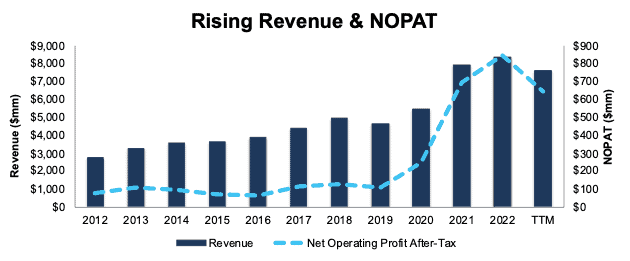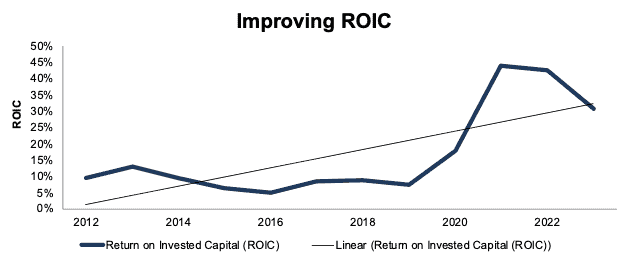Six new stocks make May’s Exec Comp Aligned with ROIC Model Portfolio, available to members as of May 12, 2023.
Recap from April Picks
Our Exec Comp Aligned with ROIC Model Portfolio (-1.6%) underperformed the S&P 500 (+0.1%) from April 14, 2023 through May 10, 2023. The best performing stock in the portfolio was up 14%. Overall, six out of the 15 Exec Comp Aligned with ROIC Stocks outperformed the S&P from April 14, 2023 through May 10, 2023.
This report leverages our cutting-edge Robo-Analyst technology to deliver proven-superior[1] fundamental research and support more cost-effective fulfillment of the fiduciary duty of care.
This Model Portfolio includes stocks that earn an Attractive or Very Attractive rating and align executive compensation with improving ROIC. This combination provides a unique list of long ideas as the primary driver of shareholder value creation is return on invested capital (ROIC).
New Stock Feature for May: Boise Cascade Company (BCC: $75/share)
Boise Cascade Company (BCC) is the featured stock in May’s Exec Comp Aligned with ROIC Model Portfolio.
Boise Cascade has grown revenue and net operating profit after tax (NOPAT) by 11% and 39% compounded annually, respectively, since 2017. The company’s NOPAT margin improved from 3% in 2017 to 9% in the trailing twelve months (TTM), while invested capital turns rose from 3.3 to 3.6 over the same time. Rising NOPAT margins and invested capital turns drive the company’s return on invested capital (ROIC) from 9% in 2017 to 31% in the TTM.
Figure 1: Boise Cascade’s Revenue & NOPAT: 2012 – TTM
Sources: New Constructs, LLC and company filings
Executive Compensation Properly Aligns Incentives
Boise Cascade’s executive compensation plan aligns the interests of executives and shareholders by tying a portion of its Long-Term Incentive Plan Performance Share Units to ROIC according to the company’s proxy statement.
The company’s inclusion of ROIC as a performance goal has helped create shareholder value by driving higher ROIC and economic earnings. When we calculate ROIC using our superior fundamental data, we find that Boise Cascade’s ROIC has increased from 10% in 2012 to 31% in the TTM. Economic earnings rose from $28 million to $453 million over the same time.
Figure 2: Boise Cascade’s ROIC: 2012 – TTM
Sources: New Constructs, LLC and company filings
BCC Has Further Upside
At the current price of $75/share, BCC has a price-to-economic book value (PEBV) ratio of 0.4. This ratio implies the market expects Boise Cascade’ NOPAT to permanently fall by 60%. This expectation seems overly pessimistic for a company that has grown NOPAT 23% compounded annually over the past decade.
Even if Boise Cascade’s NOPAT margin falls to 6% (5-yr average vs. 9% in the TTM) and the company’s revenue falls <1% compounded annually over the next decade, the stock would be worth $104/share today – a 39% upside. See the math behind this reverse DCF scenario. In this scenario, Boise Cascade’s NOPAT in 2032 would be 30% below TTM levels.
For reference, Boise Cascade has grown NOPAT by 23% compounded annually over the past decade. Should the company grow NOPAT more in line with historical growth rates, the stock has even more upside.
Critical Details Found in Financial Filings by Our Robo-Analyst Technology
Below are specifics on the adjustments we made based on Robo-Analyst findings in Boise Cascade’s 10-K:
Income Statement: we made $70 million in adjustments with a net effect of removing $8 million in non-operating income (<1% of revenue). Clients can see all adjustments made to Boise Cascade’s income statement on the GAAP Reconciliation tab on the Ratings page on our website.
Balance Sheet: we made $964 million in adjustments to calculate invested capital with a net decrease of $742 million. One of the largest adjustments was $87 million (3% of reported net assets) in asset write-downs. Clients can see all adjustments made to Boise Cascade’s balance sheet on the GAAP Reconciliation tab on the Ratings page on our website.
Valuation: we made $1.2 billion in adjustments, with a net effect of increasing shareholder value by $25 million. The most notable adjustment to shareholder value was $620 million in excess cash. This adjustment represents 21% of Boise Cascade’ market cap. Clients can see all adjustments to Boise Cascade’s valuation on the GAAP Reconciliation tab on the Ratings page on our website.
This article was originally published on May 19, 2023.
Disclosure: David Trainer, Kyle Guske II, and Italo Mendonça receive no compensation to write about any specific stock, style, or theme.
Questions on this report or others? Join our Society of Intelligent Investors and connect with us directly.
[1] Our research utilizes our Core Earnings, a more reliable measure of profits, as proven in Core Earnings: New Data & Evidence, written by professors at Harvard Business School (HBS) & MIT Sloan and published in The Journal of Financial Economics.


